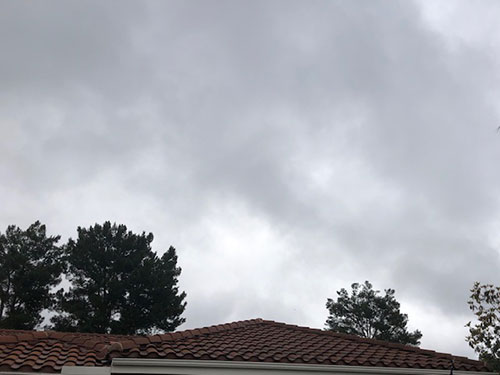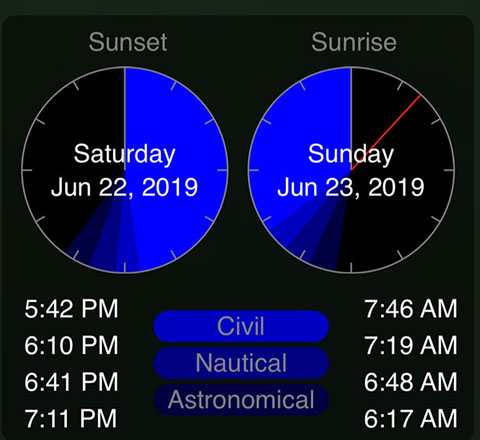We are busy packing our bags for travel to Chile for the total solar eclipse and will post our progress and hopeful success from there. For now we can report that clouds prevented us from seeing the sun on the Summer Solstice but will report on some considerations of time and season differences between observing in the northern and southern hemispheres. Also we share an interesting article on the moon and a video on the Milky Way.
First up is this article on the ancient Greek philosopher, Anaxagoras, in the June 2019 issue of online Smithsonian magazine. Anaxagoras, who lived in the 5th century BC, is recognized now as one of the first philosophers to argue for the moon being a big rock and not a god and correctly surmised that the phases of the moon were a result of the geometry between Earth, Moon and Sun. Apparently, this idea of denying that the sun and moon were gods, was not the main reason he got into trouble and put on trial. A geometric theory of the moon should have been welcome in Athens, but at the time Anaxagoras was a friend and teacher of Pericles, leader and instigator of the Peloponnesian wars with Sparta, and his political enemies could not attack him and instead chose to go after Anaxagoras. His trial resulted in the death sentence, but Pericles interceded and Anaxagoras escaped death but was forced into exile. If you are interested in more of the details be sure to check out the full article.
 |
| Great story of Anaxagoras's lunar argument and his exile (Source: Smithsonian.com, June 2019) |
So how many of you are worried about looking up at the sky and theorizing about what it means? Hopefully, we don't have to worry (much), thanks to those who came before such as Anaxagoras, Bruno and Galileo. Anyway, the other interesting find for the week, along this same line of thought of how the scientific method is based on observational corroboration, is this interesting video with Dr. Becky Smethurst, author of the soon to be published book, "Space: The 10 things you should know." In the video she discusses the history of how we came to know that the Milky Way is a spiral galaxy. She goes over the long history that started from wondering what that great band of diffuse light, that we call the Milky Way, was and what it meant about our place in the cosmos.
While everyone has wondered about these things, from the 5th century BC, when some believe that the band of light was just stars, but much further away. Dr. Becky goes on to explain how Galileo in about 1610, used his simple telescope to start to resolve the band of light into stars. She continues with the philosopher Kant and others, who argued in about 1755, that the white band of stars might be similar to the disk of our own solar system and the band of stars could be the same thing on a much larger scale.
So, Dr. Becky goes on with more of the history and how it was first necessary to be able to show the distance to the visible stars that a picture of the nature of the Milky Way. Then with the advent of infrared telescopes and radio telescopes that could see through all the dust and even through the center of the galaxy that it was slowly possible to plot the position of the Sun in relationship with the rest of the galaxy. As I recall, we now say that the Sun is located in the Orion spiral arm, one of four identified arms in the Milky Way spiral galaxy. In addition, as the measurements from Gaia satellite observatory, which include position and velocity of millions of stars in the Milky Way, are used to update the structure of the Milky Way, this will provide the most up to date view of our home.
I wouldn't be able to do her explanation and discussion any service so if you are interested in getting the rest of the very interesting story, check out the indicated YouTube video and get her book. Thanks for that interesting video, Dr. Becky!
 |
| Great story covering how we know the Milky Way is a spiral (Source: Dr. Becky, https://www.youtube.com/watch?v=yq0zyA6Yr7o&feature=youtu.be) |
Our upcoming travels to Chile brings up many issues of how being either in the northern or southern hemisphere changes the appearance of time and weather and must be accounted for when planning to make observations there. First, is the concept of summer solstice, which here in OC occurred on Friday, June 21 at 8:54 AM PDT. As you can see from the following diagram the solstice is tied to the tilt of the Earth's axis and occurs when the sun reaches the highest point in the sky and gets up to the maximum 23.45 degrees above the equator. This is called the Summer Solstice here, where we experience the longest days of the year, but in the southern hemisphere, it is called the Winter Solstice because on that same date there you would experience the shortest days of the year.
 |
| How the tilt of the Earth's axis is used to explain the solstices (Source: TimeAndDate.com) |
Well we don't participate in any special event associated with the Summer Solstice, but wanted to at least try to photograph the sun at that time. Hmm, the clouds again did not have even a bit of the sun visible as seen in this iPhone camera image taken while pointing in the direction where the sun would have been found.
 |
| iPhone photo of the sun's location, 5 minutes past Summer Solstice (Source: Palmia Observatory) |
One of our planned itinerary stops in Chile, after experience the total solar eclipse, is to spend several nights in the Atacama Desert. There we plan to see and tour some of the large observatories there and also to do some nighttime star gazing. The itinerary says that we are scheduled for some nighttime observing starting at 7:00 PM local time. What, will the sun even be down by then? Just check out this GoSkyWatch screenshot showing the sunset/sunrise times here in OC for this last Saturday. Yes, the sun will not even begin going down until like 8:00 and not really be up to dark sky standards until around 9-10 PM.
 |
| GoSkyWatch app screenshot of sunset/sunrise times in Orange County, CA (Source: Palmia Observatory) |
But we have to remember that we will be in the southern hemisphere, where it will be the winter and the same GoSkyWatch app shows that sundown begins at around 5:42 and by 7:00 PM local time it will be really dark. Ok, so it looks like starting star gazing in Chile at 7:00 PM should just be great!
 |
| GoSkyWatch app screenshot of sunset/sunrise times in Santiago, Chile (Source: Palmia Observatory) |
How does local time in Chile differ from local time in OC? Well, the first thing to consider is offset from Greenwich Mean Time (GMT), which in Chile the time is 4 hours behind GMT, while here in OC we are 8 hours behind. But there is also the issue of daylight saving time corrections. Here in OC, we are on DST and so our local time is pushed ahead one hour, while in Chile, it is wintertime and DST does not apply. So, finally, we see that local time in Chile will just be 3 hours ahead of OC, rather than the expected GMT difference of 4 hours. You can check out the details in the screenshot below from TimeAndDate.com.
 |
| Offset from GMT and effects of daylight saving time for Chile Standard Time (Source: TimeAndDate.com) |
Ok, ok, that is enough time spent considering how to account for time in different time zones and how the seasons are reversed when travelling from summer days in OC and how they will be winter days as we get off the plane in Chile. Now for life in Chile, there is a much simpler clock that we can rely on when we get to Chile, one that does not care a bit about GMT or daylight saving time, and that is best illustrated by the photo below of a refrigerator magnet, spotted at a local wine store, which shows how easy it can be to know when it is time to have a glass of wine! Yep, it's time! See how easy it can be?
 |
| No need to calculate the time for wine (Source: Refrigerator magnet at Salt Creek Wine) |
Until next time,
Resident Astronomer George
Be sure to check out over 300 other blog posts on similar topics
If you are interested in things astronomical or in astrophysics and cosmology
Check out this blog at www.palmiaobservatory.com

No comments:
Post a Comment